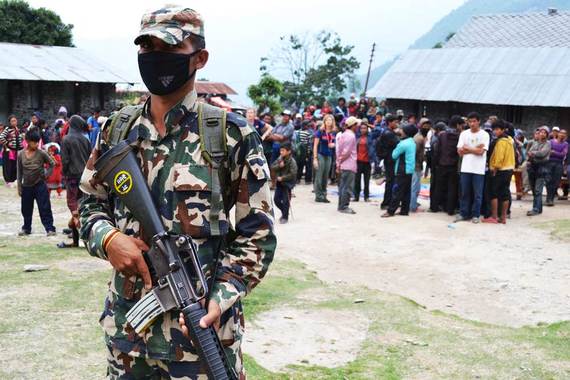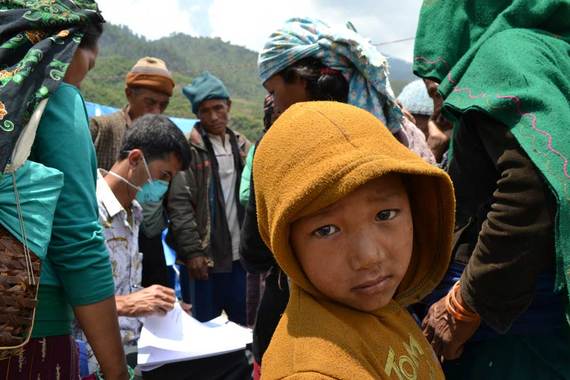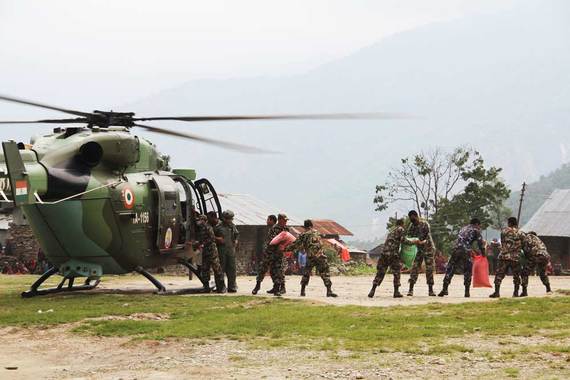
A month after Nepal's most devastating earthquake in 80 years, there are at least a few things to be optimistic about.
A grassroots volunteer effort mobilized tens of thousands of Nepalese and international citizens to come together to get aid into remote parts of the country. The global funding community has pledged to open its wallet. Nepal's neighbors -- India and China -- are jockeying to prove to the world who cares more about their little brother between them. There has also been interesting commentary about the role of aid and volunteers in light of the quake.
On the NGO front, one highlight is the work that many local and international organizations are doing to retool their programs to align with both the new disaster-specific funding as well as the important work that was already underway before April 25th. There's money for social good in Nepal to be snatched, to be sure, and with so little going Nepal's way right now, no organization wants to be the one to let the country down.
But make no mistake: a nation that was trying to find itself after a long feudal slumber has now lost its footing again.
* * *
The April 25 quake was followed in quick succession by two 6.7s, a 5.8, and a 5.7. If there was a message in all the seismic activity, it was that the diminishing tremors seemed to be signaling that the disaster was heading into a clean-up phase. That is, until May 12, when a rare 7.3 aftershock stunned geologists and set back the nascent recovery.
When the first big quake hit Nepal I was in Bali, and I read with horror the stories about so many places I loved, even my own neighborhood, in so much crisis. I was away because I had been hit with Nepal's visa restrictions which only allow me to stay in the country 150 days of each year. India, Myanmar, Thailand, Indonesia -- these may seem like exotic locations, but seen through the eyes of the visa refugee they can be as mundane as any other place. How is the internet there? What does the flight cost? Is it the rainy season right now? How is the food? Will there be too many tourists?
What burned was the fact that, had I rushed back to Nepal, my days would still be numbered by an inflexible government visa scheme that was already leading me to see Nepal's government as the problem, not the solution, to enterprise and initiative in their country. Since the quake this sense has been amplified in a thousand ways. As the Warren Buffett saying goes: When the tide goes out it's easy to discover who has been swimming naked. And in Nepal's case, the requirements of responding to a mega-disaster revealed once and for all the deadly legacy of Nepal's government mismanagement.
In the week after April 25, the Nepali press and people seemed to palpably give the government the benefit of the doubt. People were willing to believe when official spokesmen said be patient, the government was doing everything possible, aid funds would definitely be carefully spent and monitored, help was on the way, and everything was going to be okay because the people would pull together.
The cracks in the dam of public good widened into chasms after a series of bewildering, conflicting, and often plain incorrect public statements. When it was announced that henceforth all donated funds wired to NGO bank accounts in Nepal would be channeled to the Prime Ministers Relief Fund there was an outcry and many NGOs halted fundraising efforts. Soon the statement was clarified: Only funds sent to NGOs established after April 25 would be rerouted. But the damage was done.
Similarly, a government announcement that help was no longer needed and aid workers could go home was greeted with disbelief. Surely, with thousands of people still waiting for aid this couldn't be the case? Again the statement was retracted and clarified: Observers now believe it was coded language meant for India and China, who had both come in quickly with military teams rather than disaster response teams. Even after a huge earthquake, not being able to secure their own borders was a huge diplomatic embarrassment for Nepal.
And there have been bigger fails. Supply backups at the airport. Whole communities cut off from aid for weeks. A lack of training and coordination among bureaucrats on what to do. Corruption. Village Development Committees (VDCs) were left leaderless as politicians tended to their own power bases and left the greater community behind. Communities left out of communications, unvisited, languishing. Laughably little funds were kept in reserve for just such a disaster.
Saddest of all: Even if the government hadn't performed so poorly, decades of mistrust had led people to be primed to believe that the government would fail. With the civil war, a sick place-holder prime minister, and still no constitution in place, it's now clear just how unprepared Nepal's government was for the work of disaster response. When everything goes to hell, real response requires leadership, passion, and endurance -- characteristics notably absent in the first few weeks after the quake. It also requires expertise.
* * *
I got a chance to see how aid can play out firsthand on a medical mission to Lapa, in Dhading district, which I plan to write about in more detail soon. I was in the northern part of the district, near the Tibet border. The mountains are steep here, with Ganesh III looming impossibly high above the nearest crags. Transport is mainly by foot, up from Dhadingbesi several days via trails, rope bridges and switchbacks that link a series of small, progressively more remote villages. Here the earthquake had crumbled walls, killed animals, slumped crop terraces, broken water pipes, broken trails and forced nearly everyone into tents. Sixteen had died in this sub-district with one still missing. And for everyone, life was on hold here.
I was invited to serve as a media specialist, and I spent my days producing images and videos of a volunteer medical team of doctors and nurses as they gave care to close to 800 people. The highlight of each day were the helicopters that landed, often without warning, in the center of town. Military, UN and private helicopters rotated in and out, bringing a cavalcade of aid workers, supplies, food, journalists and politicians. Locals would gather in the square by mid-day, knowing that soon there were be piles of rice bags, cooking sets, salt, oil, blankets, tarps.
They had to be patient: soon local political party leaders would arrive with paper and pens, counting their following, taking stock of the booty, and slowly divvying up the goods by party membership. There was never enough for everyone, see, so you needed to have some method for figuring out who would get what and who wouldn't. In the late afternoon you could see many villagers walking back in the gloom of the falling day, hours away from their fallen homes.
Unexpectedly, I also ended up doing quick a bit of NGO relations and outreach. During our time in Lapa representatives from more than 10 NGOs came ducking out of their chairs in the helicopters. Most were in Lapa for the first time ever, conducting post-quake assessments in advance of a larger team to come. In contrast, my team had been coming to the valley twice a year for some time now, and we could see from our own data just how the health situation was changing. Dysentery, for example, was in full outbreak -- and we daily debated whether to declare an epidemic here.
But the visitors who were arriving didn't know the valley or our work, and so sensing opportunities and wanting to be helpful, I crossed the field to offer my hand, introduce them to what our team was up to and suggest they come up to the camp to see for themselves. Some did, some didn't. But all were gone within a few hours of landing, pausing just long enough to drop their supplies, take a few pictures, or ask a few questions.
* * *
For some people I am with, it seems at times that earthquakes are all anyone really wants to talk about. Others keep it inside, but start to tremble and tear up when prompted to recall where they were when the ground became terrifying.
I was invited by my didi to come to dinner at her house in Imadol, south of Kathmandu. There her husband spent an hour commenting on the front page news articles of the day's paper, all stories about the quake of course. He is a pastor and a Nepalese, and so naturally I am full of questions about Christianity in this ancient Hindu and Buddhist kingdom. Eventually I am able to ask him about this, but not until we exhaust ourselves with stories of destruction, despair and need.
The Nepali people can be sometimes superstitious by nature and prone to rumors, fantastic predictions and magical thinking. I remember, for example, a tale from last year that had NASA detecting a sunspot that was going to destroy all communications in a few days. Now, in the shadow of the earthquake, fears and anxieties are amplified by astrologers predicting huge aftershocks on specific days, or else misinterpreted interviews with far-off geologists.
I ask the pastor how he sermonizes about the earthquake. He tells me that Nepalese are becoming Christians because it is clearer, simpler and requires more from the heart than the prevailing faiths of the centuries. "There are more gods in Hinduism than there are Nepal people," he says. "It makes no sense!" We spend a few minutes comically trying to convert lakh and crore into population numbers that I can understand.
The pastor was not Hindu before he became a believer, he says. Just Nepali. For him, the practice of Hinduism had grown stale and meaningless, little more than a collection of cultural activities -- certainly not a living, breathing expression of the spirit. He says that even among the Christians there is great falsity too. For example, the father, son and mother of God cannot possibly exist, he tells me. What would God need from these human figures? That's why he can't be a Catholic.
Christian NGOs have long been active in Nepal. Now, post-quake, they are going into places like Lapa where few other organizations have been able to penetrate. In a place where so much has changed so quickly in just a few decades, I want to know what meaning his faith attributes to the quake and how he gets it across to his flock of the converted. He tells me only that all this is a test that has been preordained and that God has seen it all.
It's late and the road outside will be dark, dusty from broken plaster and dangerous from debris. On the way back I'll pass fallen temples, apartments without roof tops, empty lots piled high with rubble. But also many standing buildings and families picking up the pieces of their lives. That's what people have always done, everywhere. I don' t need to wait for some piece of wisdom that explains it all.
* * *
Reminders of my tremendous privilege are everywhere. For starters, I can leave whenever I want to. With the exception of India, which has an open door policy, the Nepalese are sort of stuck here, exploited by China which sees them as little more than a market to sell to, reviled by Bhutan which sees them as a political threat, and cut off from the rest the world by impossibly low incomes that make travel (much less getting visas) close to impossible.
Aside from a few middle-class Nepalese with citizenship and professional jobs elsewhere, the only ones leaving country in recent years have been young men who sign up as cheap labor in Qatar, Malaysia and other countries with don't-ask-don't-tell policies when it comes to workers' rights. They can earn outside of Nepal and send the money back, and millions choose to do so. But these are the strong bodies who will be needed to rebuild the country in coming years. With the economy back home in tatters, how many will leave paying jobs overseas to work for little to no pay in a small and damaged country?
Unlike them, I have no family here, no aging relatives to care for, no injured and now handicapped cousin-brothers. I hold no failed business leases or worthless mortgages. I'm not expected to go on supporting employees who can no longer work. I can choose where and when I volunteer.
And then there is my personal safety. Aside from the medical mission, I haven't slept outside in tents because I haven't had to. I rode out the 12 May aftershock three stories up in a quake-friendly, Westerner-occuped building certified up to an 8.0 shake. The wine in the bottle sloshed and the pictures and mirrors swayed and the building slowly corkscrewed but never once did I feel like I was danger.
When the grinding ended I stood in the doorway, wondering if more was to come. But it was only after the shaking stopped and I heard the shouts and cries of the neighborhood that I realized it had been a truly dangerous quake.
* * *
Today I was talking with a friend about his motorcycle, which has been having problems. When did he last start it up? "The day of the second earthquake," he said. We tell time by the quakes now.
That would be May 12th, more than two weeks after the first big shock, when a mid-day wave of 7.3 rollers chased everyone back out to their tents and froze the country in place for another two weeks. Hundreds more died east of the capital, land shifted on top of villages, tens of thousands of damaged walls crumbled. Aid groups stopped in their tracks. It wasn't quite the killing blow for Nepal, but it was close. One more like that, well, most of us just don't know what would happen.
We had a small aftershock last night around 3am. A bump against the bed frame, a half lift to one side, and then the sound of dogs barking in the lane. There have been so many that most no longer cause much commotion. "Did you feel the quake last night?" You might ask over breakfast. The answer is sometimes yes, sometimes no, and then you move on. But not before you go inside yourself for a second, wondering at what it means to live in this shifting landscape.
In my writing here it's easy to detect a bias toward despair. But I don't actually feel or see despair in Nepal one month on from the Great Quake of 2015 - just a recognition that much more work is ahead.
All photos (c) 2015 Robert Rosenthal




